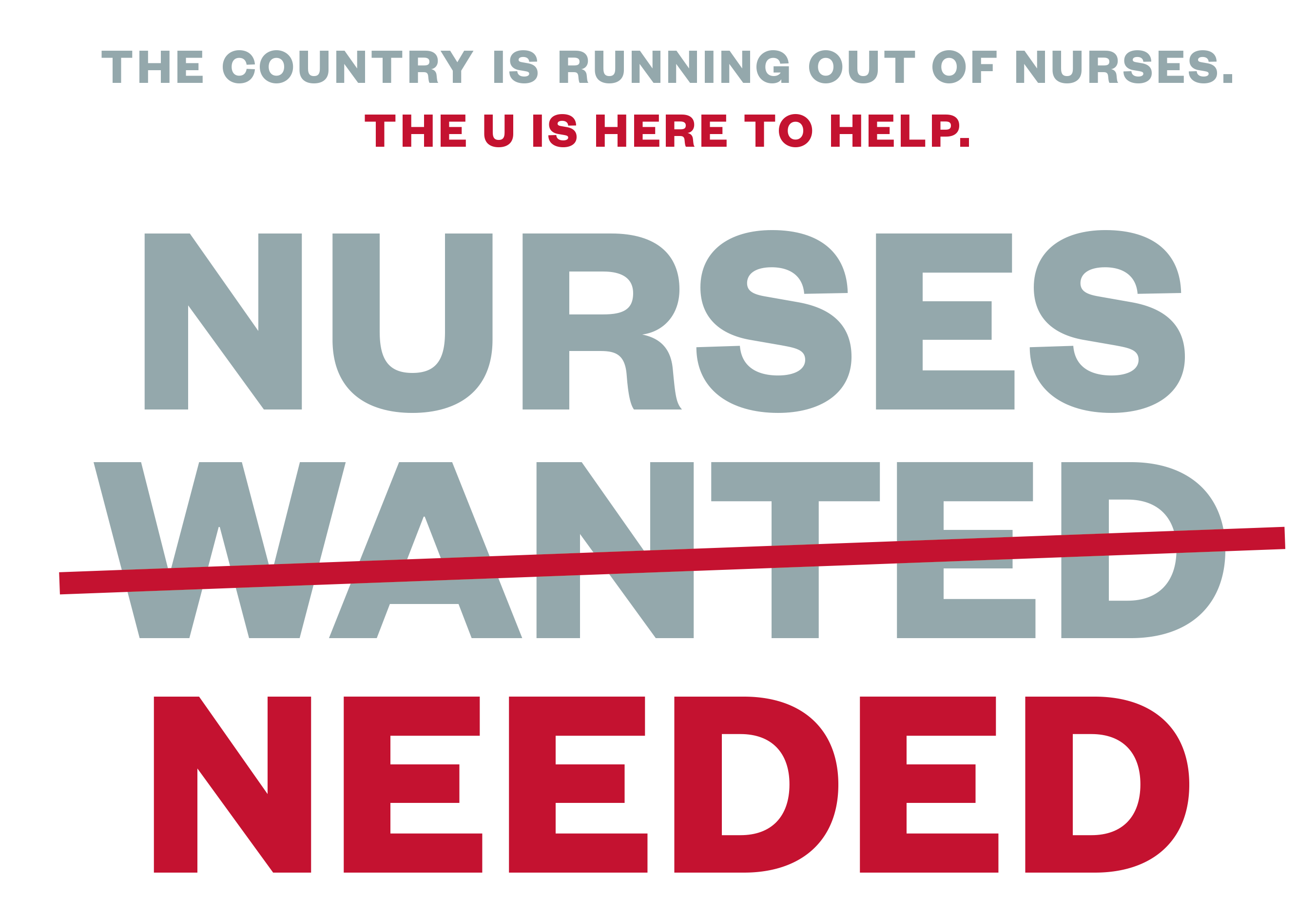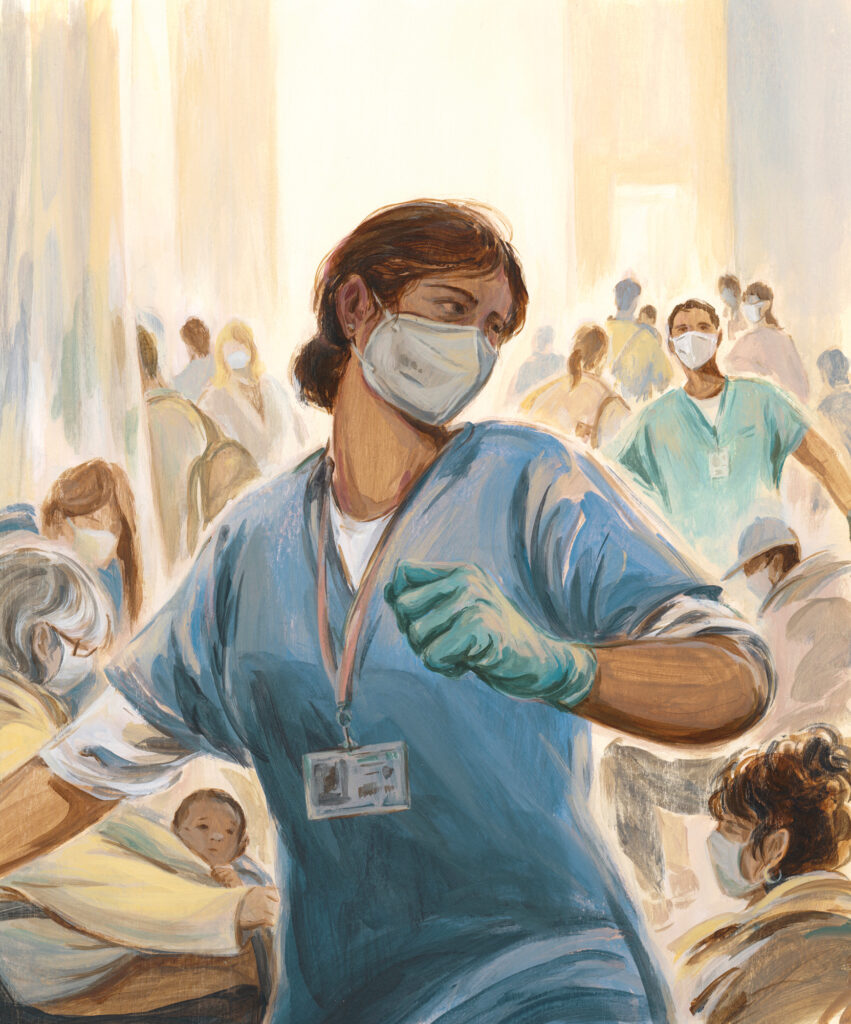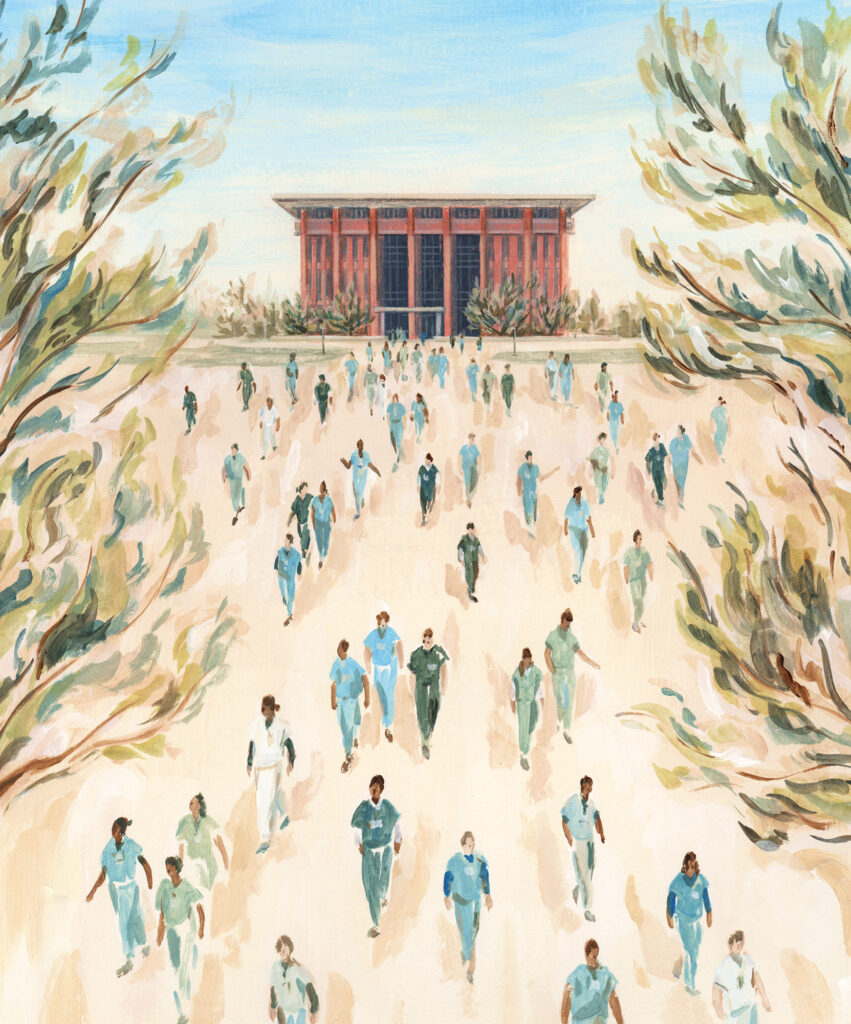
If you were hospitalized, Kenedee Le Prey is exactly who you’d want at your bedside. She’s been caring for people her whole life. Growing up with an older sister who has complex physical and cognitive disabilities, Le Prey saw nursing as a natural fit.
“My sister was a major influence in my choosing to become a nurse,” she says. “I recognized my privilege in having an able body and mind and my ability to use them to help others.”
Now a third-semester student and College Council president in the U’s College of Nursing, Le Prey looks forward to “a career where you are directly part of patients’ healing experience, where you can’t be stagnant.” But such a career didn’t always seem a sure thing. When Le Prey first applied to nursing school—before the COVID-19 pandemic—she didn’t get in.
How is this possible at a time when demand for nurses has never seemed higher?
A DIRE SITUATION
 Numbering 4.3 million, registered nurses are the largest group of health care providers in the nation, according to the American Nurses Association. They are crucial at every point of care delivery, from hospital acute care to home health.
Numbering 4.3 million, registered nurses are the largest group of health care providers in the nation, according to the American Nurses Association. They are crucial at every point of care delivery, from hospital acute care to home health.
But the current workforce is still not enough. Bureau of Labor Statistics data project 9 percent employment growth for nurses through 2030. That equates to nearly 195,000 job openings for registered nurses every year for the next eight years.
The causes of nursing shortages are complex. In short, they include low compensation, remarkably high-stress environments, and skyrocketing demand for care.
There have always been staffing shortages in nursing, says Tracey Nixon BSN’06 MSN’16, chief nursing officer for University of Utah Health. “But what we’re facing today is different,” she notes. More nurses are retiring early due to the COVID-19 pandemic, and more early and mid-career nurses are leaving the profession entirely. “Before, you just worried about having enough students to replace the retiring workforce. Now, we need to cultivate the passion, purpose, and impact of nursing to build interest in it as a profession to ensure we have a future workforce.”
Nixon points to several problems in the profession leading to the recent exodus. Wages don’t always reflect the value of care nurses provide. It requires long hours—sometimes on weekends and holidays—that disrupt work-life balance. She also notes increases in violence against health care workers, which nurses bear the brunt of.
The U.S. may face a shortage of up to 450,000 registered nurses by 2025, according to a May 2022 report from consulting firm McKinsey. The report noted that the COVID pandemic had altered career plans for many nurses, with nearly a third of RNs indicating a likelihood of leaving roles in direct patient care.
And Utah is far from immune to the shortage. Right now, the Beehive State has nearly 3,000 job openings for registered nurses. “It’s important that people in Utah, as well as the rest of the country, have an adequate number of nurses to meet their health care needs 24 hours a day, 7 days a week, 365 days a year,” says Marla De Jong, dean of the College of Nursing.
“Vacant nursing positions put stress on an already stressed workforce,” Nixon notes. “We will eventually fill that gap, but it’s years in the making.”
BEING PART OF THE SOLUTION
There’s no easy fix. But the U is searching for solutions. The College of Nursing is boosting enrollment by adding a summer track option and bringing on 36 more students each year—an increase of 25 percent. Previously, 72 students were in fall and spring cohorts, and now all three have 60 students.
“As Utah’s flagship nursing school, we are trying to ensure there are enough nurses in Utah to provide quality care for patients today and into the future,” says De Jong. This means more than just accepting additional students, though. The college is adding new personnel, including full-time and adjunct faculty, a student advisor, a clinical placement coordinator, and patient simulation specialists. It has committed more than $400,000 annually to cover the costs.
The college has also sought additional preceptors (a kind of supervisory mentor) in community hospitals and clinics to oversee students’ clinical experience. At least 900 clinical hours are required for each nursing student before graduation.
“We’re grateful to our health care partners in the Salt Lake Valley for helping accommodate the experiential aspects of our nursing education,” says Melody Krahulec BSN’05 MS’08 DNP’13, assistant dean for undergraduate programs.
De Jong acknowledges the distinct benefits the College of Nursing enjoys. “The fact that we’re affiliated with an academic health care system gives us an advantage over many other programs,” she says. University of Utah Hospitals and Clinics provide numerous clinical placements for nursing students.
In addition to building relationships with new preceptors, the college has adapted in other ways. It supplements time in clinic with simulation and has changed how it schedules clinical work, expanding to Saturdays, for instance.
“We’re very grateful for the partnerships we have that facilitate student learning,” adds De Jong, recognizing that it takes more than just college administrators and faculty to educate the kinds of nurses Utah needs.

TURNING THE TIDE
And the U isn’t done. There are plans to possibly expand the class size for each cohort, says Sonja Jensen BS’01, the College of Nursing’s director of student services. “We have a great applicant pool already,” she notes. “We want to create pipelines for people who wouldn’t otherwise have opportunities. We’re trying to identify ways to help students see themselves in the profession early and help them be prepared for our program.”
Patient outcomes are better with nurses who have bachelor’s degrees in nursing, which is why the college is looking to expand other opportunities, like its RN-BS program for registered nurses practicing with associate degrees, Jensen adds.
“This initiative is a major undertaking,” says Michael Good, CEO of U of U Health. “It is the right thing to do given the contemporary challenges we face. It’s vital that we educate, train, and deploy enough nurses in Utah and elsewhere in the Mountain West to provide the health care that residents of this region deserve and have come to expect. This new approach to nursing education will be beneficial to all.”
HOPE FOR THE FUTURE OF MEDICINE
 But a limited, short-term solution will not solve an expansive, long-term problem. “We can’t unilaterally solve the nursing shortage,” admits De Jong. “We’re fully aware that a 25 percent increase in our enrollment barely puts a dent in the number of graduates needed to fill vacant positions. But we care about the people of Utah who need health care, and we’re doing our best to be responsive.”
But a limited, short-term solution will not solve an expansive, long-term problem. “We can’t unilaterally solve the nursing shortage,” admits De Jong. “We’re fully aware that a 25 percent increase in our enrollment barely puts a dent in the number of graduates needed to fill vacant positions. But we care about the people of Utah who need health care, and we’re doing our best to be responsive.”
Nixon looks forward to those new nurses graduating. “It means nearly 40 more people than we’ve seen as potential applicants,” she says. But increasing the size of nursing cohorts is only one piece in a host of changes needed to reverse the nursing shortage.
“The entire profession needs to build excitement around nursing again,” Nixon notes. “We need to shift the narrative to talk about the great things nurses do.”
Despite immense challenges awaiting her post-graduation this December, Le Prey is a clear-eyed optimist. “After what we went through during the last two years, it would be impossible to not come out better,” she remarks.
Nixon shares that optimism. “The reason I come back every day is to help us navigate the next five to 10 years,” she says. “This is a moment of both great change and great possibility. We have to step in and shape what our profession needs to look like.”
Luckily, future nurses like Le Prey are aspiring to be the change Nixon hopes to see in the field. Le Prey recognizes that education doesn’t stop after graduation—to be a great nurse, a person must continue learning through their whole career. And she’s excited about it.
“We are the next wave, and we’re here to fill those gaps,” she says.
About the author: Aaron Lovell is associate director of marketing for U of U Health.



I couldn’t be more more proud of Kenedee than I am right now! As her mom I watched her champion the disabled since she was 2 and recognized that some people need more help than others. And the fact that it was nurses who were our rescue every time I had to spend time in the hospital with her sister gives me ever great reasons to adore her! She is a mighty force. Her level of caring should be the standard for every medical professional in health care.
I am still working my Pre-Nursing at The University of Utah. I was a part-time student and a full-time worker at The University of Utah HEALTH as Health Care Assistant. A little more courses to take. I wanted to become a Nurse. It is a big opportunity on my part to know, how much Nurses needed in the medical field. So, pray for me, my studies at The University of Utah. I was returning student this coming Spring 2023 Semester at The University of Utah.
More students is a bandaid and a floppy one at that when you don’t have any experience to teach new staff. The U must do something to keep their experienced nurses. Speaking from personal experience the U does not care to keep their experienced staff. After working for the U for 8 years the same department for 5 then 1 year as their educator, they offered my 12,000 less per year to go from an educator position back to the same floor I’ve worked for years. They absolutely do nothing to keep experienced staff. Patients are absolutely harmed by this. It’s truly a shame.
Hello, recently I got my license through NY University State, non compact State for now, I have a BSN and I am from Chile with large experience in ICU and critical care, but so far I can’t work in Utah because this is a Compact state. I feel like for foreign nurses is so difficult to work here. Regardless that I ace my NCLEX.
In my opinion, the TOEFL shouldn’t be so strict with the scores, I know a lot of foreign nurses that will be more than happy to work here as a nurse.
Spot on. Never forget the Heroes to Zeroes travesty… What a shame.
The country isn’t just running out of nurses it’s running nurses out of healthcare.
Right on. Utah in 2022 had 1/3 less nurses than it had in 2018. Guess why. 55% of nurses quit the profession for life within 5 years, one third quit in their first year. They don’t tell you that when they ask for your signature on your loans for nursing school. Utah currently has 4,000 licensed nurses who are not working as nurses.
I am a 20+ year seasoned registered nurse who currently works full time in the Insurance Industry (University of Utah Health Plans), my thoughts to add hope to the nursing shortage as of today is to allow for retired nurses or nurses who are looking for weekend work (with active licensees) to be welcomed back and be staffed in non critical areas… a few examples – SCN (taking on the feeders and growers) working in Triage, administering immunizations, placing IV’s, discharging stable pts… this would allow more nurses to take on the critical care pts and allow the seasoned nurses the gratification to take on patient care in area where they feel comfortable working.
Nurses in Utah make less than every surrounding western state.
In Utah, nurses make an average of $34.99 an hour. Nevada nurses are paid 22% more. Arizona and Colorado also make significantly more. Even nurses in Idaho bring home more money per hour than nurses in Utah, even though the cost of living in Idaho is less than in urban Utah areas.
https://www.ksl.com/article/50427440/utah-registered-nurses-are-leaving-the-field-creating-the-perfect-storm